
Most
lightning (2/3 rds) stays inside the cloud and travels between the main
positive
charge center near the top of the cloud and the layer of negative
charge in the middle of the cloud; this is intracloud lightning.
About 1/3 rd of all lightning
flashes strike the ground. These are called cloud-to-ground
discharges (actually negative cloud-to- ground lightning). We'll
spend most of the class learning about this particular type
of lightning. A couple of types of lightning are
shown in the figure
below. Positive polarity cloud to ground lightning accounts for a
few percent of lightning discharges. Upward lightning is the
rarest form of lightning. We'll look at both of these unusual
types of lightning later in the lecture.

Most cloud to ground discharges begin with a negatively-charged downward-moving stepped leader (the figure above is on p. 166 in the ClassNotes). A developing channel makes its way down toward the cloud in 50 m jumps that occur every 50 millionths of a second or so. Every jump produces a short flash of light (think of a strobe light dropped from an airplane that flashes periodically as it falls toward the ground). The sketch below shows what you'd see if you were able to photograph the stepped leader on moving film. Every 50 microseconds or so you'd get a new picture of a slightly longer channel displaced slightly on the film.

Here's an actual slow motion movie of a stepped leader. The video camera collected 7207 images per second ( a normal video camera takes 30 images per second). The images were then replayed at a slower rate. A phenomenon that takes a fews tens of milliseconds to occur is spread it out over a longer period of time so that you can see it.
As the leader channel approaches the ground strong electrical attraction develops between negative charge in the leader channel and positive charge on the surface of the ground. Several positively charged sparks develop and move upward toward the stepped leader. One of these will intercept the stepped leader and close the connection between negative charge in the cloud and positive charge on the ground.
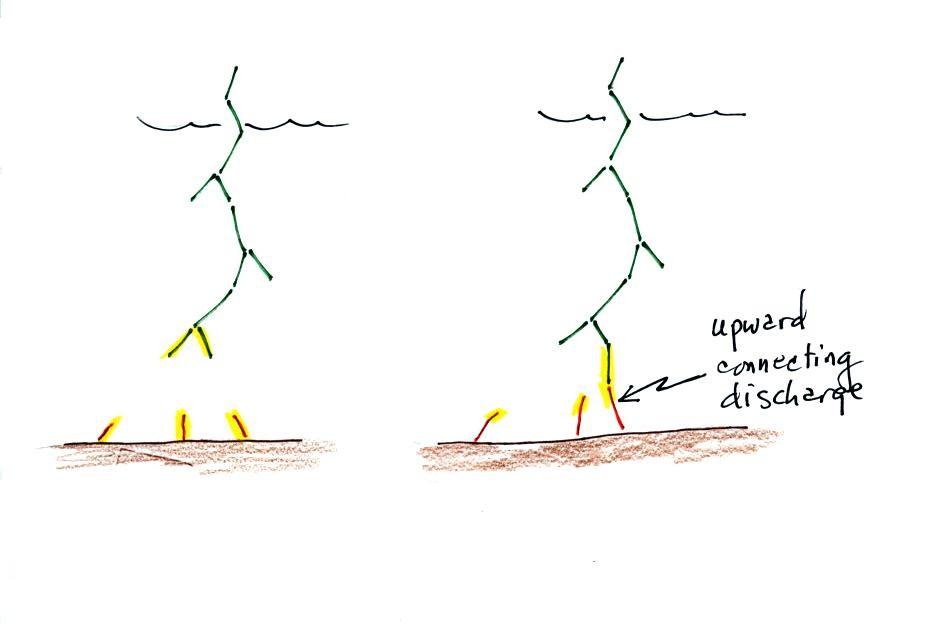
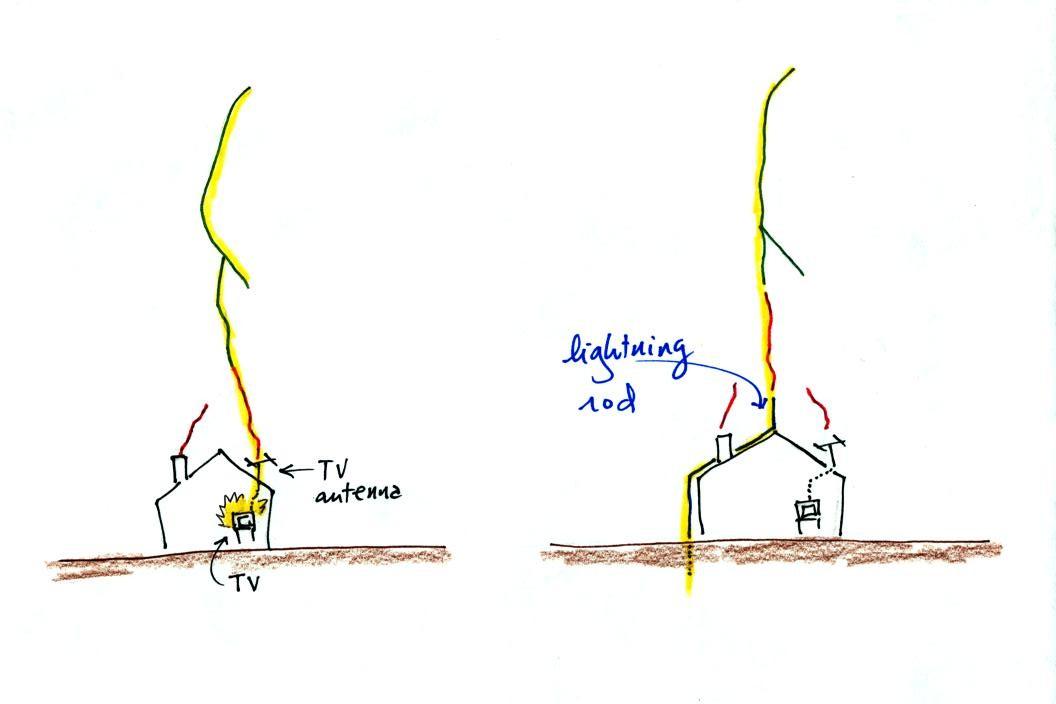
Houses with and without lightning rods are shown above. When lightning strikes the house without a lightning rod the powerful return stroke travels into the house destroying the TV and possibly starting the house on fire.
With a lightning rod, an upward discharge will intercept the stepped leader and safely carry the lightning current through a thick wire around the house and into the ground. They do work and have changed little since their initial development in the 1700s. Most of the newer buildings on campus are protected with lightning rods.
The connection between the stepped leader and the upward discharge creates a "short circuit" between the charge in the cloud and the charge in the ground.

A
powerful current travels back up the channel from
the
ground toward the cloud. This is the 1st return stroke.
Large
currents (typically 30,000 amps in this
1st return stroke)
heat the
air to around 30,000K (5 times hotter than the
surface of the sun) which causes the air to explode. When you
hear thunder, you are hearing the sound produced by this explosion.
The figure below shows what we've learned so far in simplified form
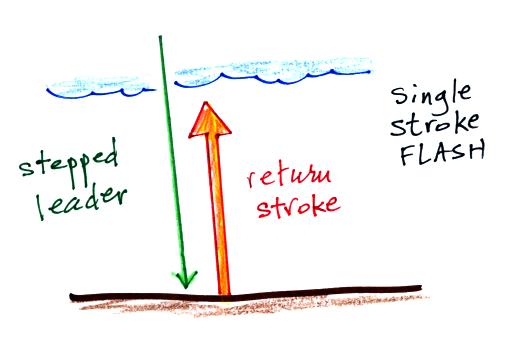
Many cloud-to-ground flashes end at this point. In about 50% of cloud to ground discharges, the stepped leader-upward discharge-return stroke sequence repeats itself (multiple times) with a few subtle differences.

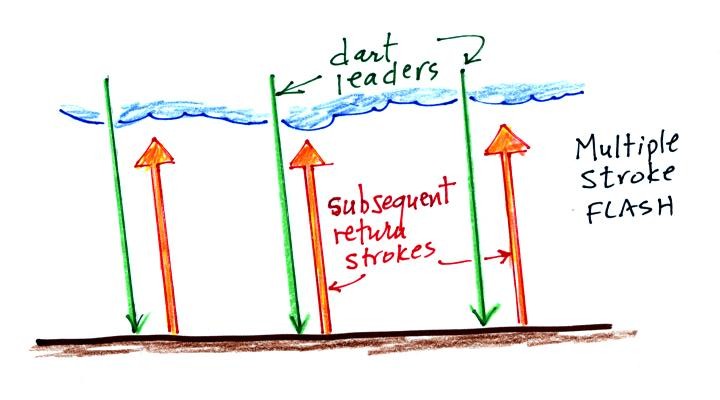
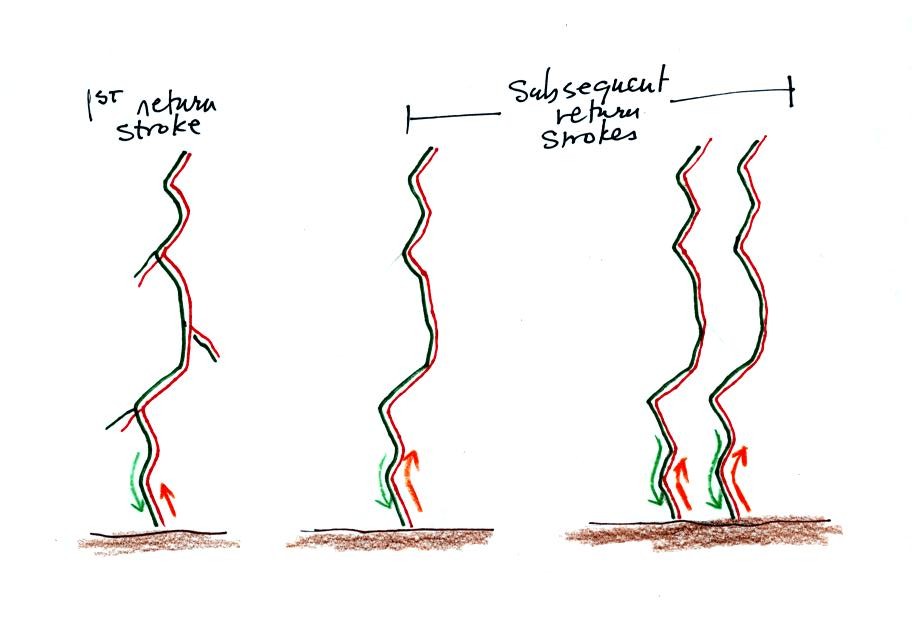
The image above shows a multiple stroke flash consisting of 4 separate return strokes. There is enough time between separate return strokes (around 1/10 th second) that your eye can separate the individual flashes of light.

When lightning appears to flicker you are seeing the separate return strokes in a multiple stroke flash. The whole flash usually lasts 0.5 to 1 second.

Most cloud to ground discharges begin with a negatively-charged downward-moving stepped leader (the figure above is on p. 166 in the ClassNotes). A developing channel makes its way down toward the cloud in 50 m jumps that occur every 50 millionths of a second or so. Every jump produces a short flash of light (think of a strobe light dropped from an airplane that flashes periodically as it falls toward the ground). The sketch below shows what you'd see if you were able to photograph the stepped leader on moving film. Every 50 microseconds or so you'd get a new picture of a slightly longer channel displaced slightly on the film.

Here's an actual slow motion movie of a stepped leader. The video camera collected 7207 images per second ( a normal video camera takes 30 images per second). The images were then replayed at a slower rate. A phenomenon that takes a fews tens of milliseconds to occur is spread it out over a longer period of time so that you can see it.
As the leader channel approaches the ground strong electrical attraction develops between negative charge in the leader channel and positive charge on the surface of the ground. Several positively charged sparks develop and move upward toward the stepped leader. One of these will intercept the stepped leader and close the connection between negative charge in the cloud and positive charge on the ground.

Here's a sketch of
one of the best photographs ever taken of an upward connecting
discharge.
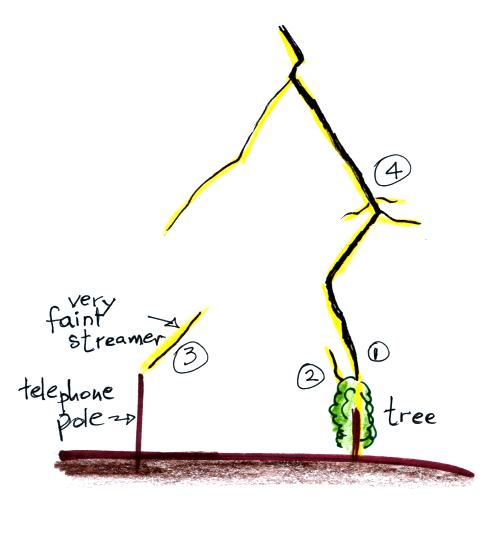
You can see the actual photograph on the photographers homepage. There were at least 3 upward discharges initiated by the approach of the stepped leader (1, 2, and 3 in the sketch). Streamer 1 connected to the bottom of the stepped leader. It isn't clear where the exact junction point was. The downward branching at Point 4 indicates that was part of the descending stepped leader. A very faint upward discharge can be seen at Point 3.
Lightning rods (invented by Benjamin Franklin) make use of the upward connecting discharge.

You can see the actual photograph on the photographers homepage. There were at least 3 upward discharges initiated by the approach of the stepped leader (1, 2, and 3 in the sketch). Streamer 1 connected to the bottom of the stepped leader. It isn't clear where the exact junction point was. The downward branching at Point 4 indicates that was part of the descending stepped leader. A very faint upward discharge can be seen at Point 3.
Lightning rods (invented by Benjamin Franklin) make use of the upward connecting discharge.

Houses with and without lightning rods are shown above. When lightning strikes the house without a lightning rod the powerful return stroke travels into the house destroying the TV and possibly starting the house on fire.
With a lightning rod, an upward discharge will intercept the stepped leader and safely carry the lightning current through a thick wire around the house and into the ground. They do work and have changed little since their initial development in the 1700s. Most of the newer buildings on campus are protected with lightning rods.
The connection between the stepped leader and the upward discharge creates a "short circuit" between the charge in the cloud and the charge in the ground.

The figure below shows what we've learned so far in simplified form

Many cloud-to-ground flashes end at this point. In about 50% of cloud to ground discharges, the stepped leader-upward discharge-return stroke sequence repeats itself (multiple times) with a few subtle differences.

A downward dart leader travels from
the cloud to the
ground. The dart leader doesn't step but travels smoothly and follows
the channel created by the stepped leader (avoiding the
branches). It is followed by a slightly less powerful subsequent
return stroke that travels back up the channel to the cloud. This
second stroke might be followed by a third, a fourth, and so on.

A normal
still photograph would
capture the
separate
return strokes
superimposed on each other. If you bumped or moved the camera
during the photograph the separate return strokes would be spread out
on the image.
Here's a stepped leader-upward connecting discharge-return stroke animation.
Here's a stepped leader-upward connecting discharge-return stroke animation.

The image above shows a multiple stroke flash consisting of 4 separate return strokes. There is enough time between separate return strokes (around 1/10 th second) that your eye can separate the individual flashes of light.

When lightning appears to flicker you are seeing the separate return strokes in a multiple stroke flash. The whole flash usually lasts 0.5 to 1 second.
Here are
some unusual types of lightning.
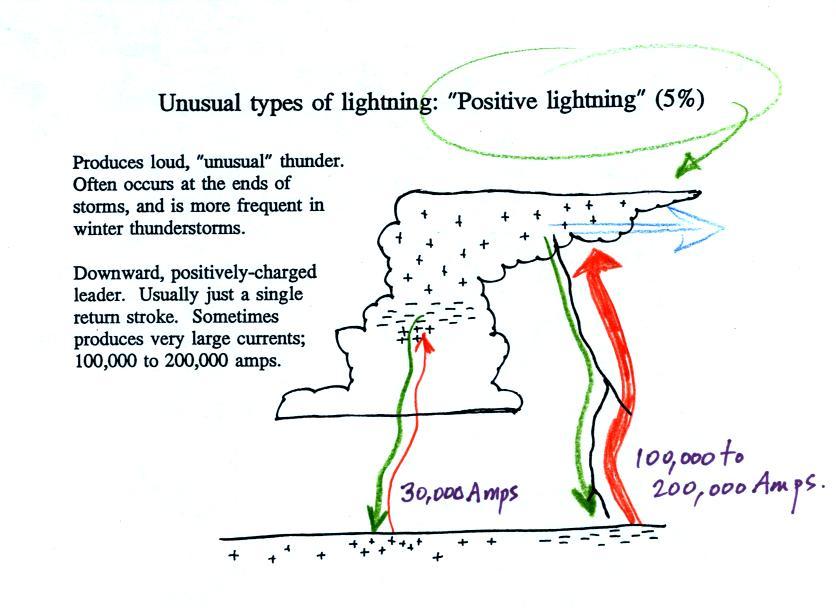

Here's an even rarer form of
lightning. Lightning
sometimes starts at the ground and travels
upward.
Upward lightning is generally only initiated by mountains and tall
objects such as a skyscraper or a tower of some kind (the Empire State
Building is struck many times every year but lightning and usually it's
lightning that the building itself caused).
Note the discharge is different in another way also. These discharges are initiated by an upward leader. This is followed by not by a return stroke, like you might expect, but by a more normal downward leader. Once the 2nd leader reaches the ground, an upward return stroke travels back up the channel to the cloud.

Scientists are able to take closeup photographs and make measurements of lightning currents using triggered lightning. Triggered lightning can also be used to test the operation of lightning protection devices. A short video showing rocket triggered lightning experiments being conducted by University of Florida scientists in northern Florida was shown in class. There are also some good videos of the experiments on YouTube.
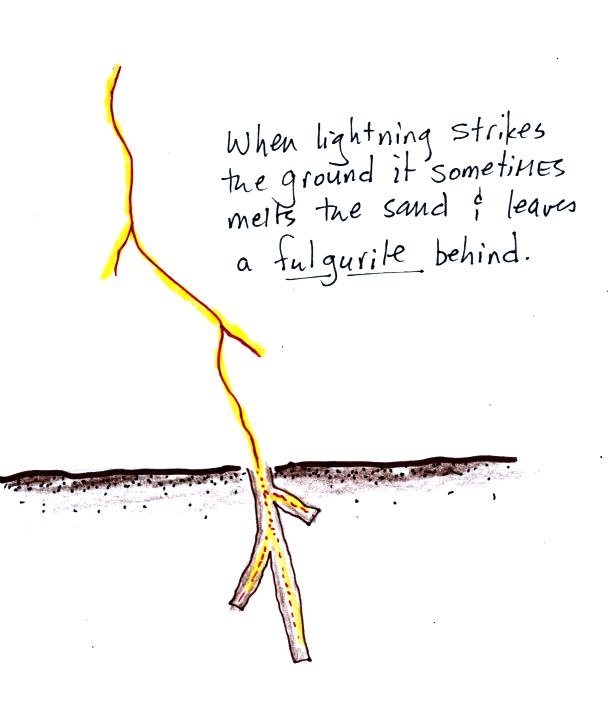
Lightning is a serious weather hazard. Here are some lightning safety rules that you should keep in mind during thundery weather.
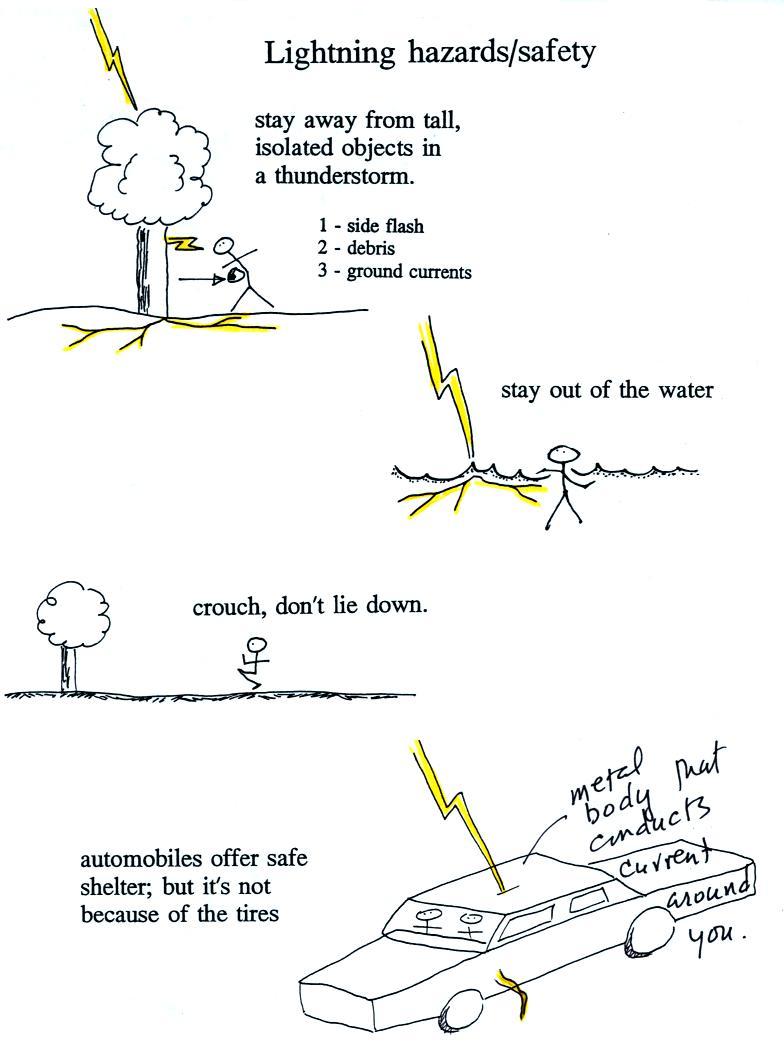
To
estimate the distance to a lightning strike
count the
number of
seconds between the flash of light and when you first hear the
thunder. Divide this by 5 to get the distance in miles.

For example, a delay of 15 seconds between the flash of light and the sound of thunder would mean the discharge was 3 miles away. Research studies have shown that about 95% of cloud to ground discharges strike the ground within 5 miles of a point directly below the center of the storm. That's a 10 mile diameter circle and covers the area of a medium size city.
The latest lightning safety recommendation is the 30/30 Rule.
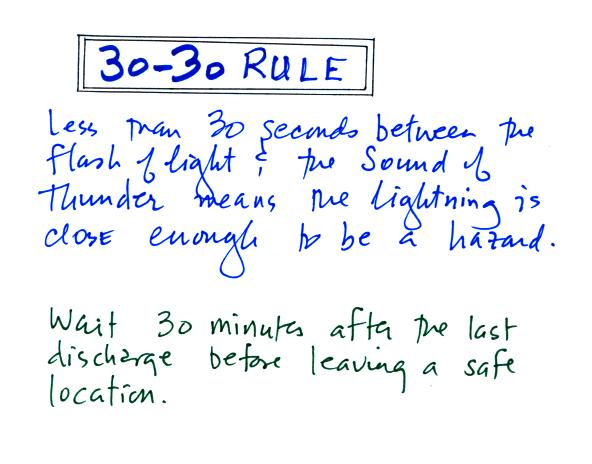
The 30/30 rule
People should seek shelter if the delay between a lightning flash and its thunder is 30 seconds or less.
People should remain under cover until 30 minutes after the final clap of thunder.
The following information wasn't covered in class and won't be on this week's quiz
Some fairly new and unusual upper atmospheric phenomena are sometimes called lightning. The figure below (source: Wikipedia) gives you an idea of where these so-called sprites, elves, and blue jets are found and sort of what they look like. They're very faint and don't last very long so they difficult to see. They don't really involve lighning channels and large currents like we have been discussing. Rather these are phenomena most likely caused by the electromagnetic fields produced by lightning.

You find some good actual pictures of sprites (mainly) at this sky-fire.tv website. A site maintained by the New Mexico Institute of Mining and Technology (NM Tech) also has some good photographs, video, and more information about these phenomena.

We've been looking at strikes that
originate in the negative charge center is a thunderstorm (discharge at
left in figure above). Occasionally a lightning
stroke will travel from the
positive charge
region in the top of the thunderstorm cloud to ground (shown at right
in the figure above). These
types of strikes are more common at the ends of storms and in winter
storms. This is probably because the top part of the cloud gets
pushed sideways away from the middle and bottom portions of the
cloud. Positive strokes are very powerful. They sometimes
produce an unusually loud and long lasting clap of thunder.

Note the discharge is different in another way also. These discharges are initiated by an upward leader. This is followed by not by a return stroke, like you might expect, but by a more normal downward leader. Once the 2nd leader reaches the ground, an upward return stroke travels back up the channel to the cloud.

The fact that lightning could begin
with an upward discharge that
begins at the ground led (French) scientists to develop a technique to
trigger
lightning by firing a small
rocket up
toward a thunderstorm. The rocket is connected by a thin wire to
the ground. When the rocket gets 50 to 100 m above the ground an
upward streamer will develop off of the top of the wire. Once the
streamer reaches the cloud it can initiate a "normal" series of
downward dart leaders and upward subsequent return strokes.
Scientists are able to take closeup photographs and make measurements of lightning currents using triggered lightning. Triggered lightning can also be used to test the operation of lightning protection devices. A short video showing rocket triggered lightning experiments being conducted by University of Florida scientists in northern Florida was shown in class. There are also some good videos of the experiments on YouTube.

When
lightning strikes the
ground
it will often melt the soil
(especially sandy soil) and leave behind a rootlike structure called a
fulgurite. A
fulgurite is just a narrow (1/2 to 1 inch across) segment of melted
sand (glass). The video showed archaeology students excavating
around the lightning triggering site after the summer's
experiments. They were able to uncover and reveal a very long
(perhaps world record length) fulgurite.
Lightning is a serious weather hazard. Here are some lightning safety rules that you should keep in mind during thundery weather.

Stay
away
from
tall
isolated
objects
during
a
lightning
storm.
You
can
be
hurt
or
killed
just
by
being
close
to
a
lightning strike
even if you're
not struck directly. Lightning currents often travel outward
along the surface of the ground (or in water) rather than going
straight down into the ground. Just being close to something
struck by lightning puts you at risk.
An
automobile
with
a
metal
roof
and
body
provides
good
protection
from
lightning.
The
lightning
current
will
travel
through
the metal
and around the passengers inside. The rubber tires really don't
play any role at all. The people in Florida that were
triggering lightning with rockets (shown on a video last week) were
inside a metal trailer and were perfectly
safe. All of the connections made to equipment outside the
trailer were done using fiber optics, there were no metal wires
entering
or leaving the trailer.
You shouldn't use a corded phone or electrical appliances during a lightning storm because lightning currents can follow wires into your home. Cordless phones and cell phones are safe. It is also a good idea to stay away from plumbing as much as possible (don't take a shower during a lightning storm, for example). Vent pipes that are connected to the plumbing go up to the roof of the house which puts them in a perfect location to be struck.

You shouldn't use a corded phone or electrical appliances during a lightning storm because lightning currents can follow wires into your home. Cordless phones and cell phones are safe. It is also a good idea to stay away from plumbing as much as possible (don't take a shower during a lightning storm, for example). Vent pipes that are connected to the plumbing go up to the roof of the house which puts them in a perfect location to be struck.


For example, a delay of 15 seconds between the flash of light and the sound of thunder would mean the discharge was 3 miles away. Research studies have shown that about 95% of cloud to ground discharges strike the ground within 5 miles of a point directly below the center of the storm. That's a 10 mile diameter circle and covers the area of a medium size city.
The latest lightning safety recommendation is the 30/30 Rule.

The 30/30 rule
People should seek shelter if the delay between a lightning flash and its thunder is 30 seconds or less.
People should remain under cover until 30 minutes after the final clap of thunder.
The following information wasn't covered in class and won't be on this week's quiz
Some fairly new and unusual upper atmospheric phenomena are sometimes called lightning. The figure below (source: Wikipedia) gives you an idea of where these so-called sprites, elves, and blue jets are found and sort of what they look like. They're very faint and don't last very long so they difficult to see. They don't really involve lighning channels and large currents like we have been discussing. Rather these are phenomena most likely caused by the electromagnetic fields produced by lightning.
You find some good actual pictures of sprites (mainly) at this sky-fire.tv website. A site maintained by the New Mexico Institute of Mining and Technology (NM Tech) also has some good photographs, video, and more information about these phenomena.